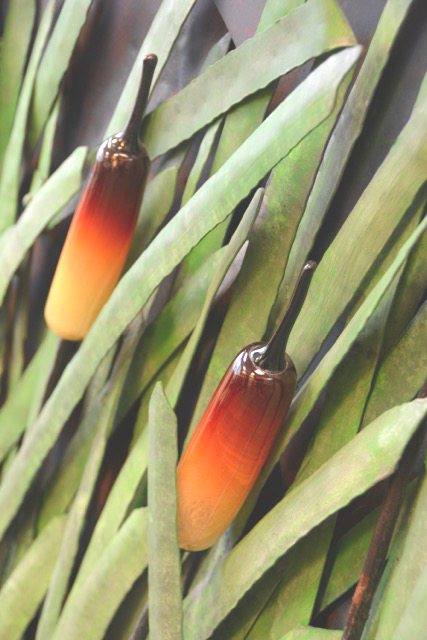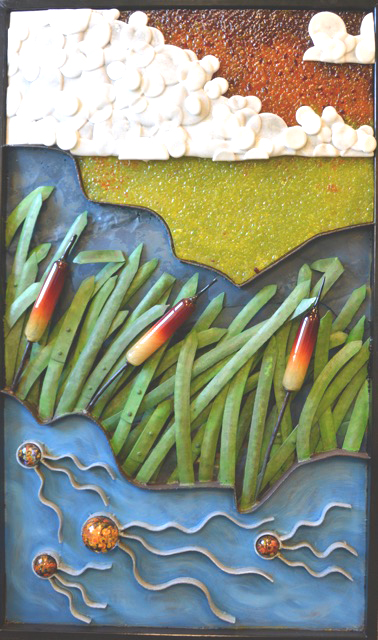The location of the unveiling, Benicia Community Center, is itself is a tribute to repurposing. A former elementary school, the building was modified for its new use in energy-efficient ways and through use of multiple recycled materials. It has been awarded Leadership in Energy and Environmental Design certification.
The multi-section art piece and its accompanying interaction and information element has been a project of the city’s Arts and Culture Commission, through its Public Art Committee, since 2012. Along the way, the commission received a grant from the Community Sustainability Commission to underwrite the project.
The original design was a single, swooping image that through the years was transformed into multiple panels.
Getting the grant application written was “no small task,” said Patty Gavin, the project’s spokesperson and chair of the Arts and Culture Commission.
“Lee Wilder Snider, a former Arts and Culture commissioner, and I came up with the idea of a recycled glass and metal piece,” Gavin said. “Through an artist selection process, the artists were commissioned.”
The artists were chosen by a panel made up of voting and at-large members of the Public Art Committee and the commission’s city staff liaisons, Benicia Public Library Director Diane Smikahl and Volunteer Coordinator Helaine Bowles.
Lead artist is Brian Giambastiani, who received his training with world-renowned glass artists at the Eugene Glass School in Oregon. A glassblower for nine years at Nourot Glass in Benicia, he opened his own studio, 1015 Designs, in 2008. His works incorporate both glass and metal.
Micheal Nourot and his son Nicholas carry on the Italian tradition of glass blowing in their Benicia studio. The senior Nourot began his work more than 35 years ago, originally apprenticing in Venice, Italy, with masters from that city and with glass artist Dale Chihuly.
Micheal has made glassworks for the pope, American presidents and major corporations, and demand is high for his recognized patterns, Scarlet Nova and Red Satin, both of which come from the Italian tradition of glass blowing.
His son, Nicholas, started participating in his parents’ studio when he was 6, and has grown to study the art at the Pilchuck School and in Murano, a major Venetian glassblowing center. He has taught at Eugene Glass School, Eugene, Ore., and has developed his own long, lean style of glassmaking.Gavin said Micheal’s brother, David, himself a welder and metal artist, often says his love affair with welding began with a spark. David taught thousands of students during his many years at Solano Community College and he has taught ornamental iron work and collaborated with his brother on multiple projects.
Another artist, David Lindsay, has more than 35 years’ experience in glass blowing.
He has studied at the Pilchuck School of Glass in Seattle, Wash., and with master glassblower Lino Tagliapietra in Italy.
Like Giambastiani, Lindsay began his career at Nourot Glass Studio, in 1976, eventually becoming a partner with Micheal Nourot.
In 1998, Lindsay and his wife, Ann, opened their own studio, Lindsay Art Glass.
Mike Kendall, an award-winning artist for more than 40 years, has studied at the Brooks Institute of Fine Arts. Most of his works are made of metal, in which he creates non-traditional sculptures. His work has been shown throughout the Bay Area and other places in both solo and group exhibitions.
The artists began meeting three years ago to design the piece’s concept, which was complete by the end of 2014.
“The artists are not only very talented, but such professionals, and have been such a joy to work with!” Gavin said. “We are very grateful for their superb efforts, very grateful for the CSC grant, and very grateful for all the approvals that allowed the project to go forward.
“Yes, the artists worked hard, and yes, the Public Art Committee worked hard, and yes, the CSC wrote a check — or more precisely the GNSC (Good Neighbor Steering Committee and) city of Benicia.” The Sustainability Commission recommended the funding, and the City Council concurred; funds came from money available in the Valero-Good Neighbor Steering Committee settlement agreement fund.
“Along with the art piece, the grant required a learning component to educate about climate change, and this task was solely the responsibility of the Public Art Committee to create, write and implement,” Gavin said.
She said electrical engineer Larry Lauber, known for his work at the Benicia Historical Museum, was instrumental in designing and completing the backlighting of the piece. Lauber has bachelor’s and master’s degrees in science from the University of Illinois, Gavin said.
“Larry’s expertise is exceptionally diverse in numerous areas, in both the public and private sector,” she said. “He recently designed and implemented an interactive learning piece at the Historical Museum.”
In addition to developing the educational component, Lauber also handled the lighting for the colorful panels.
“There were many meetings, revisions, approvals sought, discussions, invoices to approve, and more meetings — and yes, even some bumps along the road,” Gavin said about the artwork’s development.
But she said the work was worth it.
 “This has been a true collaboration between many entities,” she said. Not only did artists combine their efforts to turn multiple materials into art, the project was filmed by John Beck, who is turning his footage into a documentary available online on Vimeo (https://vimeo.com/118965246).
“This has been a true collaboration between many entities,” she said. Not only did artists combine their efforts to turn multiple materials into art, the project was filmed by John Beck, who is turning his footage into a documentary available online on Vimeo (https://vimeo.com/118965246).
Lee Wilder Snider said the public art design has five panels made of salvaged recycled materials.
“As the viewer’s eye moves along the panels, the piece transforms into strata conveying wind, water, land,” she said. “Sky is formed from chunks of slumped and textured glass. In the sky, clouds, and leaning cattails of recycled metal and glass, depict wind.
“Dichroic bits, encased in glass balls, float on plasma-cut metal to form water. Rebar strips convey current,” she said.
“Nuts and bolts meld to shape land.
“In converting salvaged, repurposed, and recycled materials into a symphony of wind, water, land, this public piece expresses the magnificence of our earth, while helping us be mindful of its fragility,” Wilder Snider said.
Among the other items viewers will see incorporated in the panels are barrel rings, angle iron, water tower straps, oil drums, recycled frit and cullet, enamels, re-used glass, cane and lighting that is made up of recycled components.
In its statement, the Arts and Culture Commission said “Wind, Water, Land” will be a permanent eco-sustainable exhibit and educational medium in the LEED Gold-certified community center.
“The intent of the artwork, funded by a Community Sustainability Commission grant and managed by the Public Art Committee of the Arts and Culture Commission, is to serve as a catalyst for reflection and action regarding the effects of climate change,” the statement said.
“As art inspires and speaks to the heart and mind of the viewer, the goal of ‘Wind, Water, Land’ is to promote environmental awareness (and) eco-sustainable education, and inspire and resonate for years to come,” the commission statement said.
 “The artwork is accompanied by an interactive component, consisting of informative and educational questions that provoke and enlighten citizens about the realities of climate change, energy consumption, and water usage,” it said.
“The artwork is accompanied by an interactive component, consisting of informative and educational questions that provoke and enlighten citizens about the realities of climate change, energy consumption, and water usage,” it said.
“Wind, Water, Land” is a large work of art, made of five 3-foot-by-5-foot panels that will be placed along the length of a wall near the Community Center’s reception desk.
“The Community Center was chosen as the site by the Public Art Committee because of its environmental integrity and because it has the capacity to reach citizens of all age,” the commission statement said.
“On any given day 295 people of all ages will pass by the artwork.”
The unveiling will take place during a reception March 21 from 1-4 p.m. in the Benicia Community Center, 370 East L St. In addition to “Wind, Water, Land,” people will see an additional exhibit of works by the participating artists, information about water and energy savings and several screenings of Beck’s documentary.
Children also will be able to participate in an ecological, sustainable art workshop.








Leave a Reply